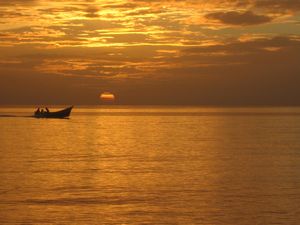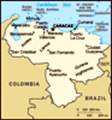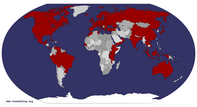Advertisement
Published: August 6th 2007

 Sunset
Sunset
Sunset over Parque Nacional MochimaThere are lots of good things to write about Venezuela. But there are also things in this country that are not so good and we believe it is only fair that we write a little about those too to balance things a little bit.
First we’d like to mention the traffic. There are too many cars in this country so sometimes it feels like the traffic is constantly jammed. The traffic jams sometimes made travelling very difficult for us. Several times we got stuck for hours. I guess the locals are used to it but I still feel sorry for them. For us it was only a bit irritating but living with that traffic every day must be very frustrating.
In Venezuela the bus drivers are totally obsessed with playing music. Often they played the music so loud that we couldn’t listen to it. Even in the night busses they sometimes played music thus making it pretty much impossible to sleep. Again I guess people are so used to this that nobody questions it. But we didn’t like it and we didn’t hesitate to show that by putting earplugs in our ears.
Venezuela has a very high crime

 Parasol
Parasol
Parasol on a beachrate. In Caracas there are many barrios, very poor suburbs, where only tourists with a death wish enter. That is not a joke. Walking through a barrio can really get you killed. Even in central Caracas there are many areas where people regularly get robbed even in the middle of the day. We stayed only a few hours in Caracas to minimize the risk of getting into trouble. We were lucky enough not to get robbed but we met other travellers and even locals who weren’t.
The crime rate is very high also in other parts of Venezuela. Twice we were told not to wander around in town after dark, in Maracaibo by a clerk at a hotel and in Maracay by a taxi driver. In Merida a man told us that if you drive a car in Venezuela and hit a red light after 7 o’clock in the evening you don’t stop. Because if you stop you might get your car jacked and if you don’t leave your car quickly enough you might even get shot.
Finally we would like to mention something that is more strange than annoying really. The personal at the hotels can say

 Iguana
Iguana
They look scary but they are not dangerous.to potential customers who wander in that they are full when they aren’t. Several times we were turned away from hotels when we asked for a room but we thought they had rooms that weren’t occupied. When this had happened a few times we started trying to find ways around it. In one hotel we asked for a double room and they answered that they didn’t have any. So instead of leaving we asked for a “matrimonial”, which is a double room with one double bed instead of a double room with two beds. And all of a sudden they had a room for us. In another hotel we asked for a room and they said they were full. Before going to the next hotel we sat down in the lobby and had a rest. After 5 minutes they had a room for us. Why they say they don’t have rooms when they obviously do we don't know. But we don’t think they try to be difficult or anything. Maybe they say “we are full” but what they actually want to say is “we don’t have a room right now because they haven’t been cleaned yet” or “we were full

 Petroglyphs
Petroglyphs
Petroglyphs, a kind of rock engravings, in Parque Archeologico Piedra Pintada. These were engraved in the rock before Europeans came to South America. last night and checkout is at noon and you can come back then but I can’t promise you any room”.
Now back to our travels. We spent one afternoon in the Parque Arquelogico Piedra Pintada. This was actually before we went to the Angel Falls, but we throw it in here anyway. Piedra Pintada is a protected area set up to preserve the hundreds of petroglyphs and the dozens of megaliths that can be found here. The petroglyphs are rock engravings thought to have had religious meaning. The megaliths are also thought to have had holy significance of some kind. There is little known what the purpose of the place really was. The size of it indicates that it was very important. It is not known how old it was but it is clear that it is pre-colonial, that is it was used before 16th century.
When we left Piedra Pintada we were offered a ride back to Maracay in a car. When we came to Maracay the woman who drove us invited us to her home. We ended up staying in her apartment for several hours and she even gave us supper.
After we left the

 Petroglyphs
Petroglyphs
Petroglyphs in Parque Archeologico Piedra Pintada. These were engraved in the rock before Europeans came to South America. Angel Falls we spent a day in Ciudad Bolivar. Ciudad Bolivar is very much like many towns in Venezuela. There are some nice colonial houses in the city centre and the rest of the town consists of not beautiful but more or less practical houses mainly built during in the 20th century. In Ciudad Bolivar, like in many other Venezuelan cities, there is little to see or to do for a tourist. One day wandering around to see the town is generally more than enough.
So after one day in Ciudad Bolivar we took off to the beach. We headed for Parque Nacional Mochima in the northeast of Venezuela. We went there to swim and rest for a couple of days. Hey, vacation isn't only sightseeing. We need to rest as well. In Parque Nacional Mochima there are several villages where you can stay. But since we are here during the low season there are very few tourists around. We therefore decided to go to one of the most popular villages in the national park - Santa Fe. We are so happy we decided to go to the most popular village because even here many facities were closed down

 Megaliths
Megaliths
Megaliths in Parque Archeologico Piedra Pintada. The stones are believed to have been used in religious activities.for the season. But at least we could find hotel room, a restaurant and transport. We guess that less popular villages might be closed down completely due to lack of business.
We actually enjoy visiting tourist sites out of season. Things are usually more relaxed when beaches and towns aren't crowded with tourists. Also we think that the locals are friendlier when there are fewer tourists around. We guess they need to take better care of business. But also it is probably because when the job is less stressful people are more relaxed and as a consequence they are more happy. What we try to say is that we had a few good days on the beach in Santa Fe.
One day we took a boat to a neighboring island. On the back from there a pod of at least a dozen, maybe as many as 20, dolphins started playing with our boat. It was a really cool experience to see the dolphins diving in and out of the water, see them swim near the bow of the boat and dive down only to reappear at the stern and to see them play with each other. Dolphins are

 Church in Ciudad Bolivar
Church in Ciudad Bolivar
Ciudad Bolivar is a pleasant little town with some nice colonial buildings. This church is one exampleamazing animals.
Not very far from Santa Fe there is a town named Araya with a large old fort - the Castillio de Santiago. During the 17th century both Netherlands and Spain had economical intrests in the northeast of Venezuela. The Dutch had a big and very profitable salt business. The Spanish wanted to take over this business and tried to get the Dutch to leave the area. In an attempt to take control of the salt plains they built Castillio de Santiago. In the mid 18th century the plains where the salt was harvested was flooded by a hurricane and the Spanish had to close down business. Consequently the fort was then abandoned. Ironically the salt business in Araya was killed by the very phenomenon that gave birth to it in the first place. The salt plain is a flat area near the ocean. When a large enough hurricane hits the town the ocean floods the salt plains. When the water afterwards evaporate the salt stays behind and can be harvested. So the Spaniards didn't have to close down business after the hurricane. All they had to do was wait until enough water had evaporated. Today salt is

 Houses in Ciudad Bolivar
Houses in Ciudad Bolivar
Ciudad Bolivar is a pleasant little town with some nice colonial buildings. These houses are a good exampleonce again being harvested in the salt plains. But there is no longer any need to protect the business. So the fort Castillio de Santiago has now crumbled into ruins.
The next place we visited was Maturin. From there we first visited Cueva del Guacharo, Venezuela's largest cave. A large part of the cave is inhabited by night living birds. The birds are sensitive to light and therefore the use of a flash is forbidden where the birds live. Without a flash it is impossible to take photos and the ones we took elsewhere in the cave didn't come out. So we don't have any good photos of the cave.
The day after we visited Cueva del Guacharo Emma decided to stay in the hotel room when Ake went to hunt a mud volcano. Since I didn't have any map and only had a very simple description to follow it took a few hours to find it. But with help from a taxi driver and some locals I managed to locate it. The volcano was hidden in a little forest so not until I was next to it I could actually see it. Just when I found the

 Sunset
Sunset
Sunset over Parque Nacional Mochimavolcano in the forest the rain started pouring down. But I was happy anyway. The mud volcano was about 50 meters across and about 2 meters high. That was much larger than I expected it to be. But I believe that the volcano was a lot larger than that. Immediately when I entered the forest I noticed that the forest was covering a small hill. I think the entire hill was actually part of the volcano. That would make the volcano at least 300 meters across and maybe 10 meters high.
The final day we were in Venezuela we visited Colonia Tovar. We tried to go there already the day we arrived in Venezuela. But we had to give up that attempt because there was such a bad traffic jam when we tried to leave Caracas. But this time we went to Colonia Tovar starting from the city Maracay and that was much more convenient.
In the 19th century a project to boost the Venezuelan agriculture was launched. The project included bringing a few hundred German farmers to Venezuela. Eventually 376 Germans were relocated from Schwarzwald to Venezuela. To ensure that the Germans would feel at home they

 Sunset
Sunset
Sunset over Parque Nacional Mochimawere given land in an isolated mountainous area were the climate is a lot cooler due to the high altitude thus mimicking a German climate. The Germans founded a village that today is known as Colonia Tovar. The original project was soon abandoned and the result was pretty much a fiasco. But the Germans couldn't return to Germany, they had to stay in Colonia Tovar. The mountains where the village is situated are pretty isolated. Therefore the German settlers for a very long time had very little contact with the rest of Venezuela. For 100 years the villagers actually weren't allowed to marry outside the village. So they kept their culture and their language for well over a hundred years. It was not until the middle of the 20th century they gave up their isolation. Today Colonia Tovar lives well from tourism. Most visitors are locals who come there mainly in the weekends to have a look at the German town in the Venezuelan mountains.
Advertisement
Tot: 0.046s; Tpl: 0.014s; cc: 8; qc: 25; dbt: 0.0227s; 1; m:domysql w:travelblog (10.17.0.13); sld: 1;
; mem: 1.1mb































Caroline E
non-member comment
Vilken fantastisk resa. Tack för att vi andra får ta del av den!